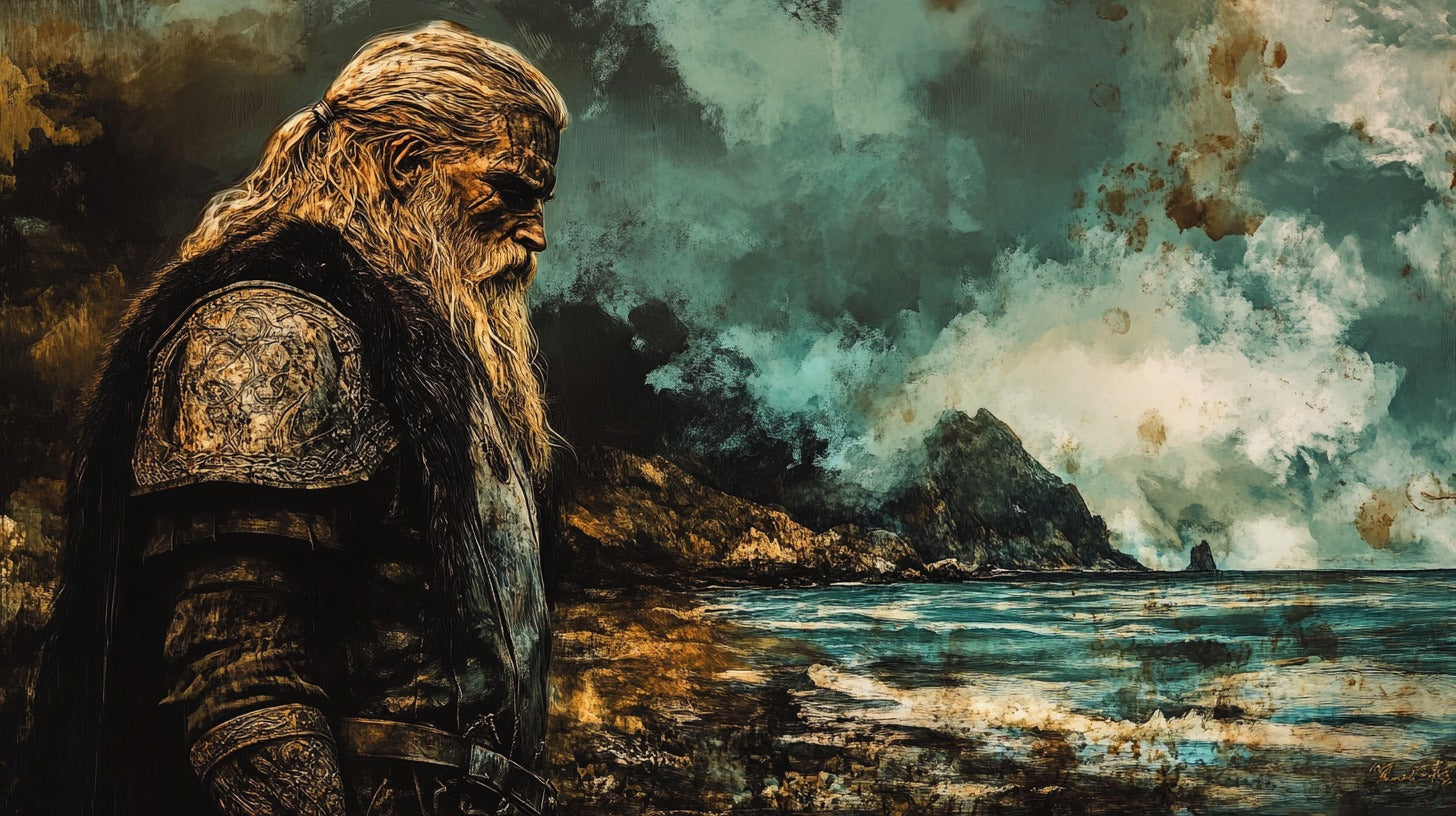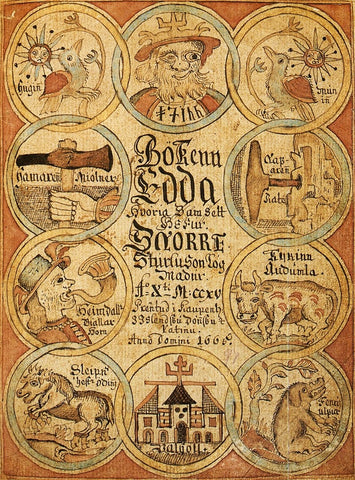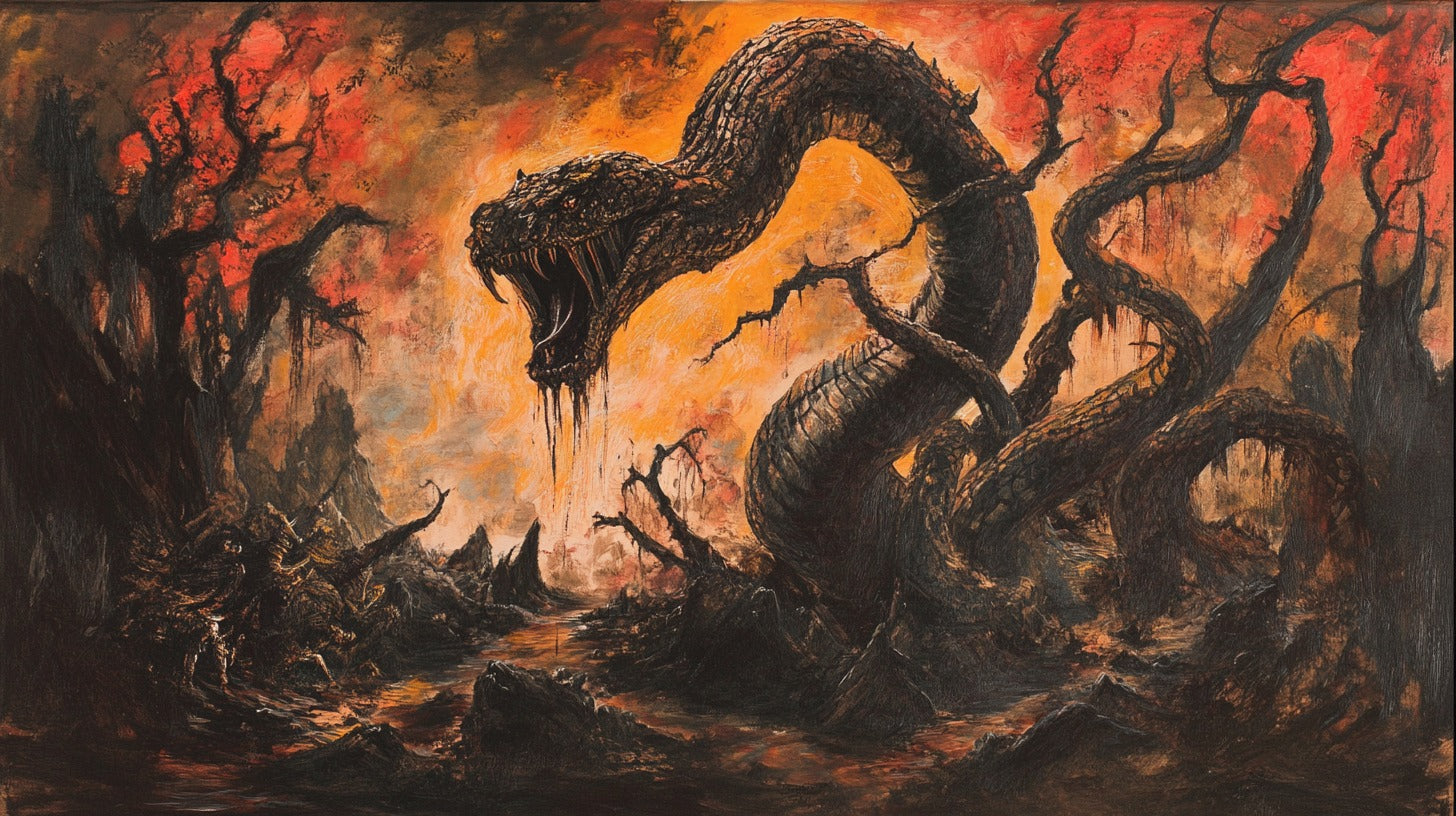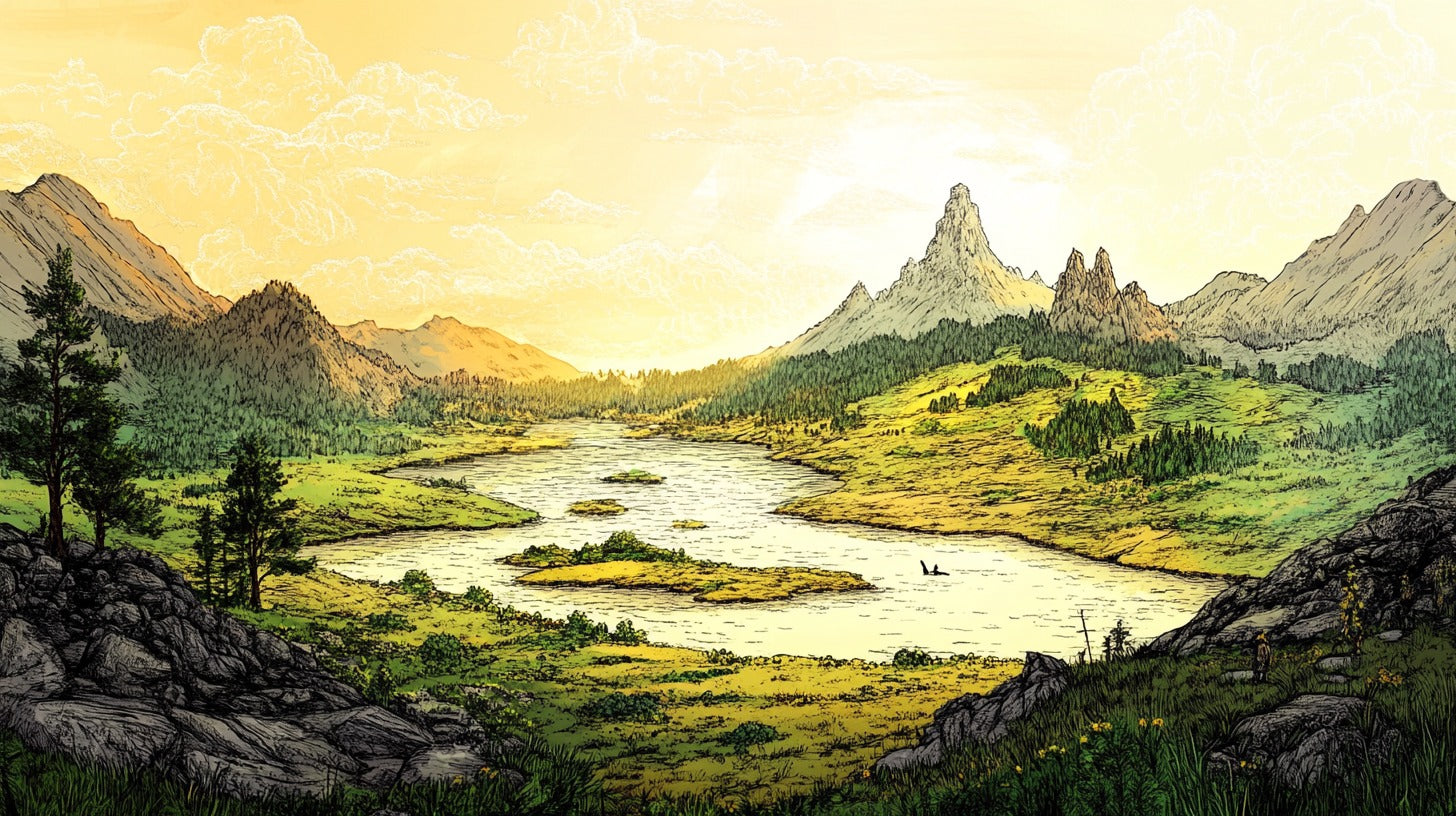
Njörðr: From Proto-Germanic Roots to Viking Age Worship
Njörðr (or Njord), a prominent deity in Norse mythology, stands as a testament to the complex and intricate belief system of the ancient Scandinavian peoples. As the god of the sea, winds, fishing, and prosperity, Njörðr played a crucial role in the pantheon of gods worshipped by the Norse. His significance extends beyond mere mythological tales, reflecting the maritime culture and economic foundations of Norse society.
Origins and Etymology

Njörd's desire of the Sea (1908) by W. G. Collingwood
Proto-Germanic Roots
The origins of Njörðr can be traced back to Proto-Germanic mythology. Linguists and historians have identified cognates in other Germanic languages, suggesting a common ancestral deity. The proto-Germanic form *Nerþuz is believed to be the precursor to Njörðr, indicating a long-standing tradition of worship predating the Viking Age (793-1066 CE).
Linguistic Evolution
The name Njörðr has undergone several linguistic transformations over time. In Old Norse, it appears as Njǫrðr, while in Old English, the cognate Neorð is attested. These variations highlight the widespread nature of the deity's worship across Germanic-speaking regions and the linguistic diversification that occurred as these cultures developed independently.
Njörðr in Norse Mythology

God of the Sea and Winds
Njörðr's primary domain is the sea, making him a crucial deity for the seafaring Norse people. He is credited with the power to calm both the sea and fire, a dual aspect that underscores his importance in a culture heavily dependent on maritime activities. The Prose Edda, compiled by Snorri Sturluson in the 13th century, describes Njörðr as dwelling in Nóatún, which translates to "ship-enclosure," further emphasizing his maritime associations.
Vanir Affiliation
In the Norse mythological framework, Njörðr belongs to the Vanir, one of two groups of gods alongside the Æsir. The Vanir are generally associated with fertility, wisdom, and the ability to see the future. This affiliation places Njörðr in a distinct category of deities, often contrasted with the more warlike Æsir gods.
Family Relationships
Njörðr's family ties are complex and, at times, controversial by modern standards. He is the father of Freyr and Freyja, two major deities in the Norse pantheon. According to some sources, including the Lokasenna in the Poetic Edda, Njörðr was married to his unnamed sister while among the Vanir, a union that produced Freyr and Freyja. However, this marriage ended when Njörðr became one of the hostages exchanged to the Æsir following the Æsir-Vanir War.
Literary References

Poetic Edda
The Poetic Edda, a collection of Old Norse poems preserved in the 13th-century Icelandic manuscript Codex Regius, provides several references to Njörðr. In the poem Vafþrúðnismál, Njörðr is mentioned as one of the hostages sent by the Vanir to the Æsir:
"In Vanaheim the wise Powers made him
and gave him as hostage to the gods;
at the doom of men he will come back
home among the wise Vans."
Prose Edda
Snorri Sturluson's Prose Edda offers more detailed information about Njörðr. In the section known as Gylfaginning, Snorri describes Njörðr's attributes and dwelling place:
"The third among the Æsir is he that is called Njörðr: he dwells in heaven, in the abode called Nóatún. He rules over the course of the wind, and stills sea and fire; on him shall men call for voyages and for hunting."
Heimskringla
In the Heimskringla, a collection of sagas about Norwegian kings compiled by Snorri Sturluson, Njörðr is euhemerized as a historical figure. He is portrayed as a Swedish king who maintained peace and prosperity during his reign, further emphasizing his association with wealth and abundance.
Cult and Worship

Illustration of the Thorsberg chape showing the runic inscriptions on both sides.
Archaeological Evidence
Archaeological evidence for the worship of Njörðr is limited but significant. Votive offerings found in bogs and coastal areas of Scandinavia have been interpreted as possible dedications to Njörðr or related sea deities. These findings suggest a widespread cult practice associated with maritime activities and prosperity.
Place Names and Inscriptions
Toponyms, or place names, provide indirect evidence of Njörðr's worship. Locations such as Nærdhæwi (modern Närdhävi) in Sweden and Njarðarlög in Iceland are believed to be named after the god. Runic inscriptions, while rare, also offer glimpses into the reverence for Njörðr. The Thorsberg chape, a piece of military equipment from the 3rd century CE found in Germany, bears the runic inscription owlþuþewaz/niwajmariz, which some scholars interpret as a reference to a priest of Njörðr.

Photo of the Thorsberg Chape taken at the National Museum in Copenhagen, in 1933. This side shown depicts Wulthuthewaz/Owlthuthewaz.
Comparative Mythology
Connections to Other Sea Deities
Njörðr shares characteristics with other sea deities from various Indo-European mythologies. Comparisons have been drawn to figures such as the Roman Neptune, the Greek Poseidon, and the Irish Manannán mac Lir. These parallels suggest a common Indo-European motif of sea gods associated with prosperity and maritime activities.
Indo-European Parallels
The concept of a deity exchanged as a hostage between two groups of gods is not unique to Norse mythology. Similar narratives exist in other Indo-European traditions, such as the Greek myth of Persephone's division of time between the underworld and the world above. These parallels have led some scholars to propose a common Indo-European mythological framework from which these stories may have evolved.
Cultural Impact

Njörðr, Skaði, and Freyr as depicted in The Lovesickness of Frey (1908) by W. G. Collingwood
Medieval Scandinavia
In medieval Scandinavian society, Njörðr's influence extended beyond religious worship. As a god associated with wealth and prosperity, he played a significant role in the economic and social fabric of Norse communities. The importance of sea trade and fishing in Norse culture further elevated Njörðr's status, making him a deity of practical as well as spiritual significance.
Modern Representations
In contemporary culture, Njörðr has experienced a resurgence of interest, particularly in literature, art, and media inspired by Norse mythology. While not as prominently featured as gods like Odin or Thor, Njörðr appears in various modern reinterpretations of Norse myths, often retaining his associations with the sea and prosperity.
Scholarly Debates

Norse Navigator: Eagle-Flanked Vegvísir Ring
Historical Accuracy of Sources
Scholars continue to debate the historical accuracy of the primary sources describing Njörðr. The main texts, such as the Poetic Edda and Prose Edda, were compiled centuries after the Viking Age and may reflect medieval Icelandic interpretations rather than original Norse beliefs. The extent to which these sources accurately represent pre-Christian Scandinavian religion remains a subject of ongoing research and discussion.
Interpretations of Njörðr's Role
The precise nature of Njörðr's role in Norse mythology and religion is another area of scholarly debate. Some researchers emphasize his function as a fertility god, while others focus on his maritime aspects. The relationship between Njörðr and other Vanir deities, as well as his place in the broader Norse pantheon, continues to be explored by historians and religious scholars.
Conclusion
Njörðr stands as a complex and multifaceted figure in Norse mythology, embodying the maritime culture, economic aspirations, and religious beliefs of the ancient Scandinavian peoples. As the god of the sea, winds, and prosperity, he played a crucial role in the daily lives and spiritual practices of Norse communities. While much about Njörðr remains shrouded in the mists of time, his enduring presence in literature, archaeology, and cultural memory attests to his significance in Norse religion and society.
The study of Njörðr offers valuable insights into the beliefs, values, and practices of pre-Christian Scandinavia. As scholars continue to analyze and interpret the available evidence, our understanding of this enigmatic deity and his place in Norse mythology continues to evolve. Njörðr's legacy serves as a testament to the rich and complex religious traditions of the Norse people, and his story continues to captivate and inspire those interested in the mythologies of ancient cultures.
FAQs
- Was Njörðr worshipped throughout all of Scandinavia?
While evidence suggests widespread worship, the extent varied by region. Coastal areas show stronger indications of Njörðr's cult due to his association with the sea.
- How does Njörðr relate to other Norse gods like Odin or Thor?
Njörðr belongs to the Vanir group of gods, while Odin and Thor are Æsir. After the Æsir-Vanir War, Njörðr became a hostage among the Æsir, integrating him into their pantheon.
- Are there any surviving temples dedicated to Njörðr?
No temples definitively dedicated to Njörðr have been discovered. However, place names and archaeological findings suggest locations where he may have been worshipped.
- How did the worship of Njörðr change with the Christianization of Scandinavia?
Like other Norse gods, worship of Njörðr declined with Christianization. Some aspects of his cult may have been absorbed into Christian practices or folk traditions.
- What is the significance of Njörðr's marriage to Skaði?
The marriage of Njörðr (associated with the sea) to Skaði (a giantess associated with mountains) represents the union of opposing forces in Norse mythology, highlighting themes of balance and compromise.








